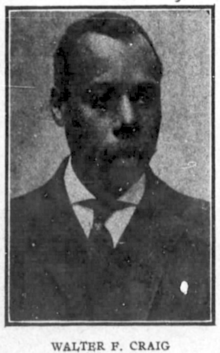Walter F. Craig
| Walter F Craig | |
|---|---|
 Craig in 1909[1] | |
| Born |
December 20, 1854 Princeton, New Jersey, U.S. |
| Died |
February 8, 1933 (aged 78) Brooklyn, New York, U.S. |
| Occupation | Musician |
| Spouse(s) | Bertie Toney-Craig |
Walter F. Craig (December 20, 1854 – February 8, 1933) was a violin soloist and orchestra director in New York City. His career started in 1870 and continued until the 1930s. He was known for his performance and interpretation of classical music, but he also was popular performing at dances.
Early life
Walter F. Craig was born in Princeton, New Jersey on December 20, 1854 to Charles A. and Sarah E. Craig. He moved to New York City in 1861 where he went to Grammar School No. 4 under Mrs. Sarah J. Smith Thompson Garnet, graduating in 1869. He began to study violin in 1868 and held his first concert at Cooper Union in 1870.[2] His musical training was under Hermon Troste, Edward Mollenhauer, and Carl Christian Muller.[3]
Career
His musical career took off and he organized what was known as "Craig's Orchestra" in 1872. His orchestra began to tour widely and he also became internationally famous as a violin soloist. As a musician, he became associated with a number of promenent vocalists including women: Madame Selika, Nelly Brown Mitchell, Adelaide G. Smith, Flora Batson,[2] Emma Azalia Hackley[4] and Sissieretta Jones[5] and men: L. L. Brown, William I. Powell, Thomas Chestnut,[2] and Harry Burleigh.[4] His compositions were also well known. He became concert master at the Mendellsohn School of Music and he was the first black conductor to be a member of the Musical Mutual Protective Union of New York City.[2] Craig's orchestra was over half white until abou 1911, and the union was criticized for not supporting Craig as much as he supported it and white musicians because Craig was black.[6] By 1887, his orchestra included 75 musicians.[3] In 1893 he was elected a member of the Antonín Dvořák-led National Conservatory of Music of America.[7] Later in his career, Craig became well known for introducing African American musicians to the stage. For example, in January 1915 he featured Roland Hayes in Hayes' premier New York shows.[8]
Craig was famous for a number of annual musical concerts. His first annual Christmas reception occurred in 1880 and continued into the early 1900s.[9] Similarly, in 1880 he presented his first Annual May Festival which also continued into the 1900s.[10] Possibly the most well renowned annual concert was his pre-lenten reception which took place at Palm Garden in New York and continued into the 1910s.[1]
Craig was at the front rank of musicianship among African-Americans and New Yorkers.[2] His work frequently interpreted classical composors with "exceptional feeling and fidelity" and was important in shaping the musical tastes of African-American in New York city. His abilities stretched beyond classical composition and his orchestra was in great demand for dance programs.[11]
Family and death

Craig married Bertie Toney-Craig. They had two children. Bertie died May 16, 1919.[12] Later in his life, Craig worked as a violin teacher[13] Craig died on or about February 8, 1933 at his home in Brooklyn[14]
Works
- Selika Galop – dedicated to Madame Selika[3]
- Arneaux March – Written for and dedicated to the drama's of John A. Arneaux[3]
- Excelsior – A grand march[3]
References
- 1 2 "Pre-Lenten Recital, The New York Age (New York City)". February 25, 1909. p. 6. Retrieved October 11, 2016.
- 1 2 3 4 5 Simmons, William J., and Henry McNeal Turner. Men of Mark: Eminent, Progressive and Rising. GM Rewell & Company, 1887. p451-453
- 1 2 3 4 5 Arneax, J. A. (May 15, 1887). "All the Colored Authors". The Sun (New York City). p. 9. Retrieved October 11, 2016 – via newspapers.com.
- 1 2 Snyder, Jean E. Harry T. Burleigh: From the Spiritual to the Harlem Renaissance. University of Illinois Press, 2016. p133, 155
- ↑ "At the Brooklyn Theatres". The Evening World (New York City). April 15, 1893. p. 5. Retrieved October 11, 2016 – via newspapers.com.
- ↑ Walter, Lester A. (November 12, 1914). "A Delicate Situation". The New York Age (New York City). p. 6. Retrieved October 11, 2016 – via newspapers.com.
- ↑ Abbott, Lynn, and Doug Seroff. Out of sight: The rise of African American popular music, 1889–1895. Univ. Press of Mississippi, 2002. p297
- ↑ Brooks, Christopher A., and Robert Sims. Roland Hayes: The Legacy of an American Tenor. Indiana University Press, 2014. p37
- ↑ "Afro-American Notes". The Brooklyn Daily Eagle (Brooklyn, New York). December 23, 1902. p. 8. Retrieved October 11, 2016 – via newspapers.com.
- ↑ "Craig's 25th Annual May Festival". The New York Age (New York City). May 18, 1905. p. 3. Retrieved October 11, 2016 – via newspapers.com.
- ↑ "Musician who Made his Mark". The New York Age, (New York City). February 11, 1933. p. 4. Retrieved October 11, 2016 – via newspapers.com.
- ↑ "Mrs. W. F. Craig Dies After Long Illness". The New York Age (New York City). May 24, 1919. p. 2. Retrieved October 11, 2016 – via newspapers.com.
- ↑ (No Headline), The New York Age (New York City) October 12, 1929, page 2, accessed October 11, 2016 16 – via newspapers.com
- ↑ Harlem, Spokesman (Chicago, Illinois) February 11, 1933, Volume I, Issue 6, page 7